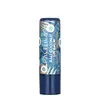What's inside
What's inside
 Key Ingredients
Key Ingredients

 Benefits
Benefits

 Concerns
Concerns

 Ingredients Side-by-side
Ingredients Side-by-side

Prunus Amygdalus Dulcis Oil
Skin ConditioningHydrogenated Coconut Oil
EmollientEuphorbia Cerifera Cera
AstringentSimmondsia Chinensis Seed Oil
EmollientTheobroma Cacao Seed Butter
EmollientHelianthus Annuus Seed Wax
Skin ConditioningCitrus Aurantifolia Peel
Skin ConditioningArgania Spinosa Kernel Oil
EmollientGlucose
HumectantCetearyl Alcohol
EmollientAroma
Citrus Nobilis
Citral
PerfumingLimonene
PerfumingCalcium Sodium Borosilicate
Titanium Dioxide
Cosmetic ColorantTin Oxide
AbrasiveHc Yellow No. 10
Blue 1 Lake
Cosmetic ColorantPrunus Amygdalus Dulcis Oil, Hydrogenated Coconut Oil, Euphorbia Cerifera Cera, Simmondsia Chinensis Seed Oil, Theobroma Cacao Seed Butter, Helianthus Annuus Seed Wax, Citrus Aurantifolia Peel, Argania Spinosa Kernel Oil, Glucose, Cetearyl Alcohol, Aroma, Citrus Nobilis, Citral, Limonene, Calcium Sodium Borosilicate, Titanium Dioxide, Tin Oxide, Hc Yellow No. 10, Blue 1 Lake
 Reviews
Reviews

Alternatives
Ingredients Explained
These ingredients are found in both products.
Ingredients higher up in an ingredient list are typically present in a larger amount.
Aroma refers to an ingredient, or mixture of ingredients, that impart or mask a flavor.
The name is slightly confusing. This is because INCI associates aroma with flavor instead of smell.
Here is the official definition from the The International Cosmetic Ingredient Dictionary and Handbook:
“Aroma is a term for ingredient labeling used to identify that a product contains a material or combination of materials normally added to a cosmetic to produce or to mask a particular flavor.”
INCI shows the only purpose of aroma to be "flavouring".
However, due to regulation differences, some companies may use aroma in place of parfum.
In Canada, this ingredient only has to be listed in concentrations above 1%.
Learn more about AromaThis oil comes from the seeds of the desert shrub called Jojoba. It is more commonly known as jojoba oil, a non-comedogenic oil.
Jojoba oil does not contain fragrance and has many fatty-acids, making it a great soothing ingredient.
It also contains Vitamin E, a great moisturizing ingredient. Vitamin E is also an antioxidant and protects your skin against oxidative damage.
This ingredient humectant properties, meaning it helps draw moisture from the air. This helps keep your skin hydrated.
While jojoba has antibacterial properties, it is only able to kill some strains of bacteria.
Studies also show it helps in wound healing. In fact, Indigenous cultures have used jojoba as a moisturizer and to help treat burns for centuries.
Fun fact: Jojoba oil similar to natural human skin sebum, so it has a great effect on dry skin. It is also promising with helping to regulate sebum production.
Due to its fatty acid content, Jojoba oil may not be fungal acne safe. We recommend speaking with a professional if you have any concerns.
Learn more about Simmondsia Chinensis Seed OilTheobroma Cacao Seed Butter comes from the Theobroma cacoa, or Cacao tree. Cacao trees are native to tropical landscapes.
Like other plant butters, Cacao seed butter is an emollient. Emollients help soothe and soften your skin. By creating a barrier to trap moisture in, emollients help keep your skin hydrated.
Cacao seed butter contains antioxidants known as polyphenols. Antioxidants help fight free-radical molecules by stabilizing them. Unstable free-radicals may cause damage to your skin cells. Antioxidants may help with anti-aging.
Theobroma Cacao Seed Butter can be bad for acne prone skin.
Learn more about Theobroma Cacao Seed Butter